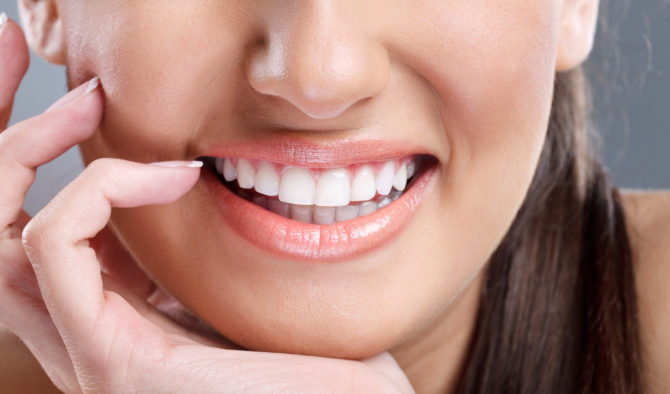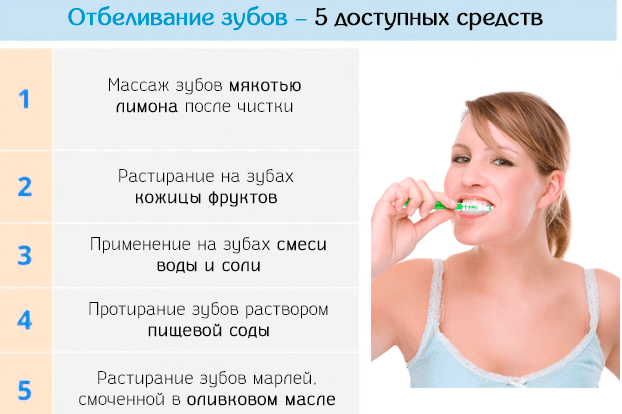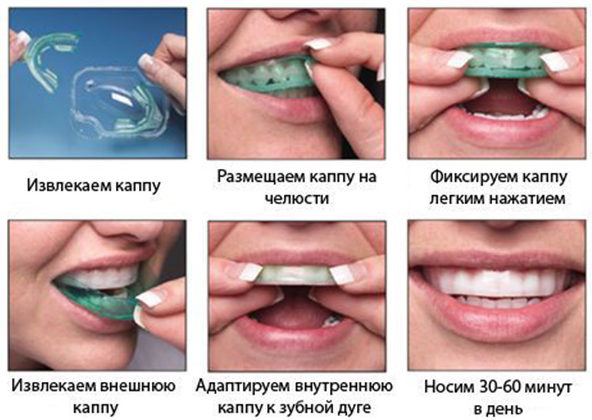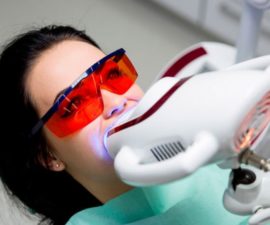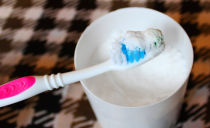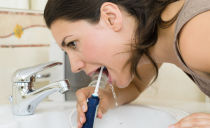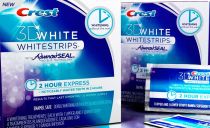How to whiten teeth at home and not damage the enamel
The natural color of enamel is never white - it ranges from light beige to pale yellow. However, the canons of beauty impose on people precisely a snow-white, so-called, Hollywood smile. To become the owner of the same, some turn to professionals, while others try to whiten their teeth at home, because it is quite possible to do it just as quickly and without harm to enamel. The safest methods of self-bleaching will be discussed in the article.
Content
Why tooth enamel changes color
This process is based on completely physiological reasons. A constant load on the chewing apparatus leads to a gradual thinning of the enamel, which significantly affects its protective properties. Enamel is gradually becoming more susceptible to various coloring substances contained in food. This process is especially noticeable with regular use of tea and coffee, in smokers.
Over time, it becomes clear that even regular use of hygienic pastes is not effective enough, and you have to think about how to whiten your teeth at home and, preferably, safely.
How to whiten your teeth at home
Proceeding to any procedure for changing the color of enamel, in no case should you forget about caution. The inept use of folk remedies in attempts to whiten teeth at home will quickly lead to such damage that not every dentist can cope with the consequences.
Adhering to the following recommendations, you can safely change the color of enamel using almost any recipe:
- Any lightening manipulations are carried out only on healthy teeth. The presence of dental diseases is a contraindication, even caries in the initial stage must first be cured by a dentist.
- It is not allowed to get bleaching reagents on the mucous membranes of the tongue or gums. Otherwise, burns are possible.
- It is permissible to use only one type of procedure. When whitening teeth, many are tempted to use several methods at home - without harm to enamel, you can not do here. Therefore, stop should be only one way.
- It is necessary to change the diet. After any procedure, it is necessary to exclude coffee, tea, wine, dark types of berries from the diet: blackcurrant, mountain ash, in order to avoid the repeated appearance of plaque and darkening of enamel.
Traditional whitening methods
This includes methods using fairly common and relatively harmless products that can be bought at any store or pharmacy.
Baking soda or sodium hydrochloride
This is the most common remedy because of its availability and prevalence. There are two ways to lighten enamel with soda:
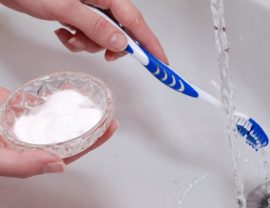 On a toothbrush moistened with warm water, soda is poured into a thin layer, after which the teeth are cleaned in the usual way. You can pour the powder into a plate and dip a brush into it for a more even distribution.
On a toothbrush moistened with warm water, soda is poured into a thin layer, after which the teeth are cleaned in the usual way. You can pour the powder into a plate and dip a brush into it for a more even distribution.- Add soda to your usual toothpaste.It is not necessary to try to place it directly in the tube - you can squeeze a small amount of paste onto a plate, pour sodium hydrochloride on top in a ratio of 1:10 or 1:20, mix thoroughly. To clean the enamel with the resulting mixture.
The first method is suitable for those who have pronounced plaque, and the second method is safer, since with it the probability of mechanical damage to the enamel with soda particles is significantly reduced. Use both methods once a week.
Hydrogen peroxide
The second most popular, but more dangerous, remedy. You can buy peroxide in a pharmacy. To clean the product, a cotton ball is moistened, which is then wiped with enamel.
It should be remembered! Do not use pure peroxide - it should be diluted with water 5-10 times. When processing enamel with a concentrated product, it is almost impossible to whiten teeth safely, especially at home.
The best option for using peroxide to brighten enamel is rinsing. To do this, add 20-40 drops of the drug to 100 milliliters of water and rinse your mouth with the resulting mixture. Then you need to rinse it with clean water as soon as possible.
Activated carbon
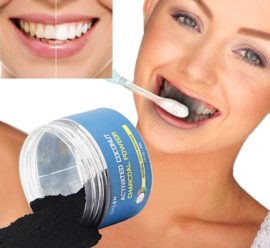 That's what, and activated carbon can definitely whiten your teeth at home and without any harm. This is due to the fact that coal is completely harmless and practically does not contain abrasive particlesthat can damage the enamel. Its action is due to the ability to absorb coloring matter.
That's what, and activated carbon can definitely whiten your teeth at home and without any harm. This is due to the fact that coal is completely harmless and practically does not contain abrasive particlesthat can damage the enamel. Its action is due to the ability to absorb coloring matter.
Before use, the tablet is thoroughly kneaded, and then either applied to a wet brush, or mixed with a toothpaste.
Do not abuse traditional methods, the interval between procedures should be at least 5 days. There are other substances with which you can whiten tooth enamel, but their use is more dangerous, so they are not recommended for use.
Folk whitening methods
This includes all those methods that were invented at a time when dentistry did not yet exist as a branch of medicine. Here are just a few of them.
Enamel whitening with fruit juices
Many fruits and berries contain organic acids. They belong to the class of weak acids, that is, they are not able to dissolve metals, but they cope quite well with organic pollutants, which darken the color of the teeth.
What fruits and berries can be used:
- Strawberry;
- wild strawberries;
- lemon;
- orange;
- sour apples.
Berries can be chopped in a blender, and the toothpaste obtained can be brushed. But you can make it even simpler: a handful of berries are chewed, the resulting slurry stays in the mouth for 10-15 minutes. After that, the oral cavity is rinsed. Do the same with apples.
Citrus "bleaches" are used by rubbing the tooth enamel with zest. You can use lemon juice with the addition of soda or other components, but this is unsafe, very unpleasant and even harmful.
Tea tree oil
This tool, in addition to improving the color of enamel, has a weak antiseptic effect, moreover, it is completely safe for whitening teeth at home.
Before using the oil, you need to brush your teeth as usual. Then, 3-4 drops of the substance are dripped onto the used brush and the cleaning is repeated. The final stage is rinsing with acidified lemon juice water. During the procedure, there is a feeling of coolness or numbness in the mouth - there is nothing wrong with that.
Eggplant Pulp
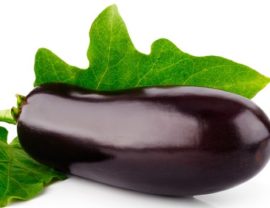 This vegetable contains a large amount of pectin and BAS - biologically active compounds with a whitening effect. To use the pulp, the vegetable is pre-baked in the oven, you can also use the microwave. Then the product is crushed to a paste, and the resulting mass is applied to the enamel with a toothbrush. The exposure time is 10 minutes, after which the mouth is rinsed with warm water.
This vegetable contains a large amount of pectin and BAS - biologically active compounds with a whitening effect. To use the pulp, the vegetable is pre-baked in the oven, you can also use the microwave. Then the product is crushed to a paste, and the resulting mass is applied to the enamel with a toothbrush. The exposure time is 10 minutes, after which the mouth is rinsed with warm water.
The advantage of this method is that it can be used for people with delicate gumswhen there is a tendency to increased bleeding. The number of whitening procedures is unlimited.
Teeth Whitening Products
Do not think that the cosmetics industry has not tried to create tools for home teeth whitening - such services are very much in demand. The assortment of goods from this group has become quite wide, and you can choose a tool just for yourself.
Whitening paste
The funds available to everyone are convenient to use and combine both preventive and therapeutic effects. When using such pastes, the enamel darkening speed is significantly reduced, and it is much less often to resort to whitening methods.
Whitening gel
Unlike pastes, such a gel does not brush your teeth. To whiten the enamel, a gel is applied to it and a certain period is maintained. The exact exposure time must be found in the instructions - each manufacturer has a different time.
For ease of use, the gel is most often sold complete with special mouth guards, which are special “containers” for the teeth. During their operation, the clarifying gel is placed directly in the mouthpiece, and already it is worn on the teeth. With the help of a cap, it is very convenient to whiten your teeth at home without a dentist.
Whitening strips
Simplified use of the gel. Such products are paper or polymer strips with a bleaching agent already applied to them. Ease of use makes it very popular. The strip is glued to the teeth and aged from 5 minutes to half an hour. To lighten the enamel by 2-3 tones, it is enough to use them for 1.5–2 weeks.
Tooth whitening pencil
A convenient form of application of the same whitening gel. The product is applied to the enamel surface using a special device resembling a pencil. The main advantage of the method is that it allows you to more accurately control the process of applying the gel.
All special teeth whitening products were developed by serious companies. The research took into account many nuances: the state of enamel in people of different ages, ethnic groups and others. The safety of their use was also evaluated, which suggests that with the help of these products it is possible to whiten teeth at home without harm to enamel.
Professional methods
Before making a decision on teeth whitening at home, it is worth familiarizing yourself with the methods that aesthetic dentistry offers:
- Mechanical whitening is the effect on the surface layer of teeth with the help of abrasives that simply remove dark enamel.
- Ultrasonic brushing - exposure to enamel with high-frequency sound waves. In the form of a bonus, the patient also receives enamel polishing.
- Laser whitening. During this procedure, a photopolymer material is applied to the teeth, in which, when it is irradiated with a laser, active oxygen is formed, effectively “corroding” tartar and plaque, which helps brighten the enamel.
- Chemical lightening is the most common way. The bottom line is exposure to the enamel with chemical agents. Here, the aforementioned hydrogen peroxide or urea, urea and chloride compounds are used.
Calling a professional dentist costs money, but with this choice, the risk of damaging the enamel is significantly reduced. Moreover, in comparison with home methods of teeth whitening, professional methods allow you to achieve results in fewer procedures and lighten enamel to a greater number of tones. Remember: healthy teeth are not always white, and the whiteness of teeth does not indicate their health!

